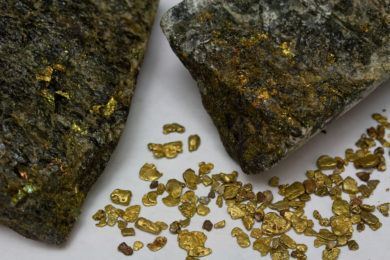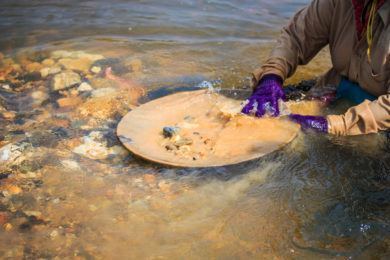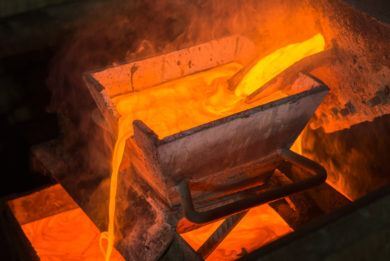Historically, gold mining practices have been seen as hazardous to the environment, with the most significant issue being the use of mercury and cyanide to leach the gold from the ore. Mines have answered this call by implementing failsafes to protect the environment and ensure efficient and safe practices. Today, General Kinematics is working with our customers to find even more ways to separate gold and make the process greener and safer.
Starting around 1000 CE, mercury was used to extract gold through a process called amalgamation. The mercury would surround the gold and form shiny pellets. Workers would then burn the pellets, allowing the mercury to evaporate, leaving the purified gold.
Gold Leaching Practices
In large-scale operations, cyanide is the dominant chemical used in leaching gold from the rocks. Cyanide has made it possible for mining companies to mine low-grade ore bodies for microscopic flecks of gold and silver, and still turn a profit.
In gold mining, cyanide solution is sprayed over vast heaps of crushed ore that is spread atop giant collection pads. The cyanide dissolves the gold from the ore as the solution trickles through the heap. The pad collects the now metal-impregnated solution, which is stripped of gold and resprayed on the stacks until the ore is depleted.
A New Way to Extract Gold
As it turns out, the modern solution for a green gold mining operation, without mercury or cyanide, requires nothing more than water, gravity, and skill.
To help the process, modern gold mining equipment manufactured by General Kinematics, such as vibrating feeders, screening solutions, grinding & attrition machines, grind, separate, and transport the excavated ore into a sluicing system that begins the real process of separating the gold. The ore passes through a crusher and roller mill until it’s broken down into smaller pieces, then it heads to a shaking table where the tiny flecks of gold are separated out.
Sluices use water to wash the ore or alluvium down a series of angled platforms, usually inclined at 5 to 15 degrees. As the water washes the sediment down the sluice, the heavier gold particles sink and are captured by a carpet-like material that covers the bottom. Sluices are good at concentrating large amounts of ore and sediment in a relatively short time but often do not yield concentrates with high amounts of gold. The resulting concentrate must usually undergo further methods of concentration, such as panning.
Panning uses water to separate heavy gold particles from other lighter particles within a medium-sized pan. In this process, sediment or ore thought to contain gold is placed in a wide, curved pan along with water. The miner moves the pan in a series of motions designed to eject lighter sediments. The density of gold keeps it on the bottom of the pan as the lighter material is ejected along with water. After a series of successful iterations have been completed, gold will be exposed on the bottom of the pan for the miner to recover.
Panning works best when gold is coarse and well liberated. Under the right conditions, panning can produce high-grade concentrates or even liberated gold. Then miners can employ gold recovery methods such as direct smelting (described below), although many panning operations lead to directly recoverable gold.
Panning offers miners a low-cost method of gravity concentration, but it requires time and skill to be effective. One of the major drawbacks to panning is that miners must pan small amounts of concentrate. Therefore, panning is often done after other methods of gravity concentration have been completed.
Other separation methods, like custom GK vibratory screens and spiral concentrators use water, gravity, and built-in ridges and grooves to separate the lighter material from the heavier gold particles. If employed properly, each of these methods should yield a high-grade concentrate with a large proportion of gold relative to other materials. Regardless, this gold still needs to be separated from the other remaining minerals before it can be sold.
The Final Steps in Gold Mining
At this point in the process, direct smelting is employed as the final stage of gold recovery. During direct smelting, the high-grade concentrate is heated until the gold melts. The liquid is then cooled to form a solid mass of gold doré, a semi-pure gold alloy, that can reach upwards of 95% purity.
This process of extracting the gold from ore is done without the use of mercury or cyanide. While these green gold mining techniques might be sufficient for the artisanal and small-scale gold mining sectors, such as those in Mongolia, greener gold mining options are still in the exploration phase for larger mining operations. For larger companies to adopt greener gold mining techniques, they would need to ensure that they could process enough ore while still remaining profitable.
Some countries have decided to ban the use of mercury. However, because cyanide leaching is so efficient, it will likely remain the preferred method for large-scale operations for the foreseeable future. This is because cyanide leaching allows for the profitable mining of much lower ore grades. But, mining lower grade ore also requires the extraction and processing of much more ore to get the same amount of gold.
Why is it Getting Harder to Acquire Gold?
Many analysts and researchers believe that we have already reached the limit of “peak gold”- the maximum rate at which gold can be mined. This means that the extraction and processing of the resource will continue to slow down until, eventually, it will stop altogether.
Global gold production fell by 1% last year, according to the World Gold Council. This is the first decline that we have seen in over a decade, and may likely be linked to the COVID-19 pandemic. However, even though gold production has started to slow down, the demand for the resource has not. Gold has consistently been seen as a stable form of currency and has seemingly only increased in value over time. During a pandemic when the currencies of several countries have decreased in value, more and more people have turned to gold as a valuable resource that will maintain its value.
At General Kinematics, our mining division is working with the industry to design disruptive and environmentally-friendly technology that will make it easier to separate and extract gold along with other precious metals and minerals for both large and small-scale operations. Contact us today to learn more!









